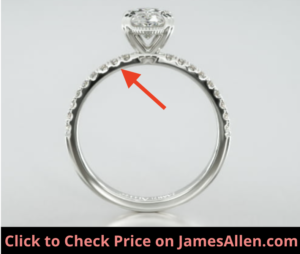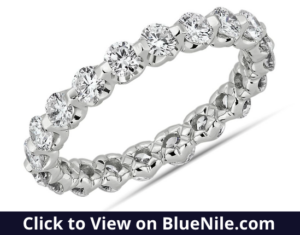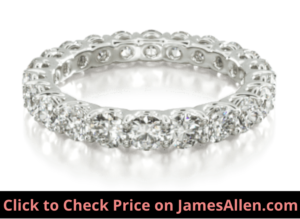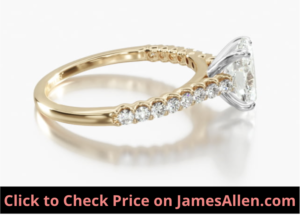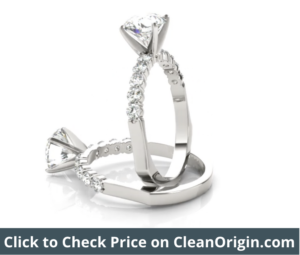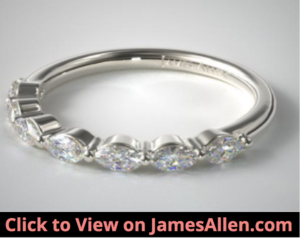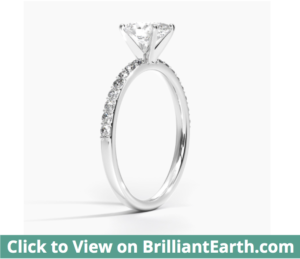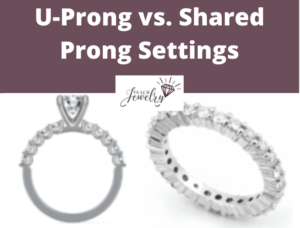
If you’re looking for the perfect diamond ring, you’ve likely spent most of your time searching for the diamond. While it’s the most prominent part of the piece, don’t underestimate the importance of the right setting.
U-prong and shared prong settings are two popular choices for diamond rings.
The main difference between U-prong and shared prong setting is U-prongs hold the diamond in a semicircle shaped like a U, where the design is apparent from the profile view. Shared prongs hold diamonds between two prongs that each extend from the ring.
Let’s explore U-prong versus shared prong settings, including an overview of each, their pros and cons, differences, and how to decide which is right for you.
What are U-Prong Settings?
A U-prong setting features a U-shape at its base that extends upward to hold the diamond.
Traditional prongs form a V at the bottom, with each pair of the four prongs creating a point where they meet the shank. U-shaped prongs have a rounded semicircle instead.
Check out the engagement ring below, from the vendor where I bought my wife’s engagement ring.
I’ve highlighted the distinct feature.
Notice how the diamonds sit close to the ring, held in place by the U-shaped set of prongs.
Some variations, known as a basket setting, include an additional piece of metal extending horizontally to connect each prong.
U-prong settings are similar to the typical style because the diamond is still grasped by four thin, metal prongs. The area it differs is the shape of its base.
U-prongs are mostly used to hold accents along the shank of a ring. For an engagement ring, there’s a main stone that sits at the top, and U-prongs cascade down both sides to hold smaller diamonds.
When used in a wedding ring, it’s known as an eternity band. U-prongs wrap all the way around the ring, each holding a diamond accent.
When the diamonds only circle half the ring, it’s called a half eternity. For example, the ring below has U-prongs holding small diamonds that go all the way around.
They add brilliance to the ring but at a more affordable price than if the diamonds were in a full eternity.
Pros
Visibility
The first pro is the shape showcases a significant amount of the diamond compared to other types of settings. Settings are often judged based on how well they display the diamond.
Because they’re the most important parts of the ring, many buyers don’t want too much of the metal shank covering them.
When used to hold the center diamond, U-prong settings show all four sides of its sides. Other settings, such as a full or partial bezel, hide the edges, so there isn’t as much visibility.
In an eternity band, it still minimizes how much of it is covered.
Notice how in the setting below, the table and both sides of the pavilion are still visible.
U-prongs allow light to enter each side, instead of blocking it with metal.
Fit Multiple Cuts
Additionally, U-prongs are fit for certain cuts such as:
- Round
- Cushion
- Princess
- Asscher
- Radiant
Their shapes sit well within the U-prongs.
The sharp corners of a princess cut land squarely with each of the four prongs, and the same is true of the four rounded edges in a cushion cut.
Many online diamond stores allow you to mix and match settings and cuts. I recommend choosing a U-prong and seeing which cuts are available to place inside.
Less Likely to Snag
U-shaped settings also don’t snag as easily. The sharp ends of traditional prongs catch on hair and clothing, which pulls the tips back.
Because the ends of some U-prongs face upward, this isn’t as much of a problem. You can run your finger along the tips of the prongs and don’t have to worry about them catching on anything.
But I still recommend removing your jewelry during physical activity.
Cons
Durability
One downside to U-prong settings is their fragility compared to other types of settings.
You may avoid snagging, but its thin metal prongs are vulnerable to breaking. While it’s inconvenient to have prongs repaired, the real danger is diamonds falling out.
When prongs are loosened as a result of a drop or a hit against a hard surface, the diamond may slip out.
But it’s worth noting that if you choose a piece from a quality jeweler, it’s still unlikely to break unless it experiences hard impact.
Not Fit for Certain Cuts
U-prongs can hold many diamond cuts, but it’s not the right fit for every shape. You should avoid the following cuts:
- Heart
- Oval
- Pear

The unique shape of these cuts don’t fit squarely in U-prongs.
Pear cuts have both rounded and sharp edges and often need to be held in multiple points around its elongated shape.
The unique outline of heart and oval cuts result in these diamonds mostly being used as the center stone instead of placed around the ring.
What are Shared Prong Settings?
Shared prong settings also include diamonds on the ring’s shank.
They’re held together by adjacent prongs that minimize how much extra metal is on the band. The tips are bent over the table of the diamond to hold it in place.
To illustrate, here’s a shared prong setting viewed from the profile.
Check out the piece on the vendor’s website, where you can rotate it 360 degrees in high resolution.
If you focus on one of the small diamonds, you can see they’re grasped by four separate prongs. But each of those also play a role is supporting another diamond.
That’s why they’re called “shared” prongs.
Each diamond is set closely together, so unless you’re viewing the setting from close up, it will look like a uniform row of diamonds with no separation between them.
Shared prongs are often confused with pave or channel settings because of the way the accents are set in the band.
Pave diamonds are held in place by small beads of metal instead of prongs.
Channel settings feature a crevice cut inside the band where the diamonds sit. Notice the difference between this channel setting and the way diamonds are held by shared prongs.
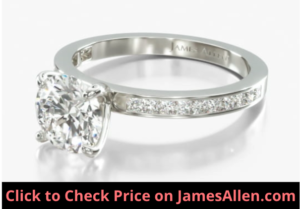
Like U-prongs, shared prongs come in multiple variations. The standard design is a single row of diamonds, but a double-row shared prong setting has two lines of gemstones.
Most instances use the same cut for each row, but you can also create an aesthetic with one row of round diamonds and another of princess cuts.
Shared prong settings are also used for wedding bands in eternity styles. Small gems are set around the entire band, so you can match the setting used in your engagement ring.
Pros
Security
The first advantage is they better secure the diamonds. They’re pressed tightly to each other and prongs, so you don’t have to worry about them slipping out.
For example, check out the high-resolution of the setting below.
The diamonds on the shank are held in four positions for added protection.
Maximizes Light
The design also maximizes the amount of light that can enter the accents.
While there’s enough metal to keep the diamonds in place, the design intentionally minimizes how much metal is present on the shank to prevent it from blocking light.
Shared prong settings won’t diminish light entering through the diamond’s table, even if its sides are partially covered.
It’s why they’re fit to complement step-cut diamonds like Asscher and emerald cuts. Those diamonds don’t display the same white light as brilliant cuts, so the shared prong setting can compensate.
Holds Multiple Cuts
It also holds several types of cuts.
Whether round, princess, or marquise cut diamonds, each is fit for shared prongs.
The shared prongs below hold marquise cut diamonds.
Each is also encapsulated in a rounded band of metal, so the sides are blocked.
You can match the cut used as the main diamond in an engagement ring, or contrast the traditional round diamond with the modern appearance of princess cuts.
Cost
Lastly, shared prong settings cost less than many other designs. It requires less metal than bezel, pave, or channel settings.
If you’re looking for an affordable setting with room for accents, shared prongs can be the right choice.
You’ll reduce the cost even more if the total carat weight (CTTW) of the setting is broken into many diamonds. For example, if the CTTW is 0.30, a setting where 10 diamonds make up that 0.30 carats will generally cost more than one with 25 small diamonds.
Cons
Repairs
Any setting with multiple small diamonds is difficult to repair. If diamonds do fall out, it’ll require a professional to put them back in.
If you lose the diamond, you’ll have to find one of the exact size to replace it because it will need to fit within the existing prongs.
As you can see in this shared prong setting, there isn’t much room for error in between the prongs.
In most cases, they weigh about 0.01 carats, so they aren’t expensive.
Some shared prongs have rounded ends, but claws or V-shaped prongs have the potential to snag.
This is often a problem for traditional prongs holding a single diamond, and it’s even more of an issue for a setting with dozens of smaller prongs.
Cleaning
The setting is also difficult to clean. If dirt or debris accumulates between two adjacent diamonds, there’s little separation.
I recommend having a professional clean your shared prong setting at least once a year to keep grime from collecting in and around the setting and its diamonds.
How are U-Prong and Shared Prong Settings Different?
U-prongs are a type of shared prong setting. In comparing U-prong versus traditional shared prong settings, one difference is the profile of U-prongs.
Its base forms a wide U-shape not found in most shared prongs.
Instead, the shared prong setting often features metal wrapping around the base of the accents instead of a semicircle with a hole in the middle.
The image on the right demonstrates this feature.
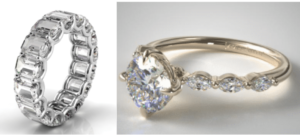
Another difference is the degree to which the diamond is exposed. The goal of a U-prong setting is to display as much of the diamond’s four sides as possible.
This enhances its overall appearance by not hiding the diamonds from light.
How to Decide Between U-Prongs and Shared Prongs
Deciding between a U-prong and shared prong setting is about prioritizing which features are most important to you.
Here are some guidelines to use.
Choose a u-prong setting if:
- You favor the U-shape at the base
- You want to maximize the brilliance and light performance of diamond accents
- You’re looking for an eternity style band as a wedding ring
Consider a shared prong setting if:
- You want to ensure the diamonds are secure
- You want to explore a variety of designs and ways to place the accents
- Affordability is important, but you want to include gemstones on the shank
You can decide which types of gems you want to place within the setting and how that complements the main stone.
By understanding U-prong and shared prongs and how they’ll affect the appearance and quality of your jewelry, you can find the right piece for you.

Jacob Clarke
Jacob Clarke is the founder of TeachJewelry.com.
He earned an Applied Jewelry Professional Diploma from the Gemological Institute of America (GIA) and now brings you essential information about diamonds, settings, and more.
Jacob has consulted with leading jewelry brands, and his work has been cited in Clean Origin, Diamond Nexus and industry publications.
He's also a member of the International Gem Society.
He enjoys discussing jewelry with readers, so contact him with any questions at jacob.clarke@teachjewelry.com.

